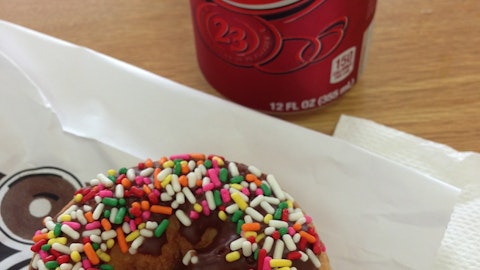Ryals McMullian: Yes, it could. I mean, it would definitely depend on the brand and what that brand brings to the consumer. I mean, it is a crowded category. So, we want to be careful that we’re investing in the right segments of that category. But, yeah, there are definitely opportunities out there we’d be interested in.
Bill Chappell: Great. Thanks so much.
Ryals McMullian: Thanks, Bill.
Operator: Thank you. One moment for our next question, please. Our next question comes from the line of Mitchell Pinheiro with Sturtevant & Company. Your line is now open.
Mitchell Pinheiro: Hi. Good morning.
Ryals McMullian: Hey, Mitch.
Mitchell Pinheiro: Hey. I guess, a couple of questions here. First, you spoke a lot. You spent time in the — in your script about private label and you’re seeing sort of improved trends, but you still have — you still wary on — you’re just not sure where it’s going. And I’m curious are you seeing the positive or a trend back to brands even into here in August? And what you might be looking for as signs of either of movement in either direction?
Ryals McMullian: Yes, sure. Great question. So, a couple of things there. Private label still gained share in the quarter. But I think it’s important to note that, that growth is slowing. And this was — towards the end of the quarter was the lowest that we’ve seen in terms of gains for private label this year. So that’s definitely on a good trend. The other thing to remember, and we’ve talked about this all year, this is — the private label phenomenon is playing out more in mass than it is in grocery. It actually lost share in grocery. Continues to gain in mass. We’ve talked about there’s been a little bit of channel shift, as consumers seek bargains in mass, club, dollar, that sort of thing. I do think also that it’s important to note that the private label share gains are generally confined to that loaf category, the traditional products.
In other words, those with the lease differentiation. Private label lost share in virtually every other category where you tend to see more differentiation, so especially breakfast, sandwich, buns and rolls, that sort of thing. So, the trend towards premiumization is definitely still there. Clearly, consumers are still looking for bargains, but that trend is headed in the right direction from our standpoint as we look to build our branded business. Mitch, I’d also point to, and we did mention this in the pre-recorded commentary, Dave’s had a great quarter, up 7% in units in the syndicated data. That’s a really, really good sign, particularly given its premium positioning. If you recall, about 20% of Dave’s Killer Bread shoppers are low-income households.
It was a surprising number to me when I first found out, but that’s where we were really starting to lose a lot of the unit volume. And in fact, earlier in the year, Dave’s units had turned negative. Well, now those low-income shoppers are coming back to the brand and helping us achieve that nice unit growth in the second quarter and were positive for the year. We did also gain some penetration in higher-income households to help. So, just all of those factors put together give us some confidence that consumer health is improving. Now we did caution everyone that we’re not ready to call the play yet. We’d like to see that trend continue well into the third quarter before we conclude that it’s here to stay, but definitely some really nice early signs.
Mitchell Pinheiro: Thank you. And then, looking at your foodservice in the other category, I mean, how much pricing — is there still pricing to go there? Number one. Number two, are you seeing any pushback on pricing so far? And as these volumes come down, how does that have an impact on your gross margins?




